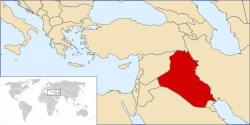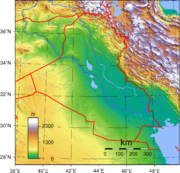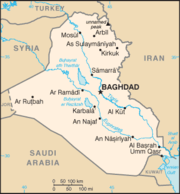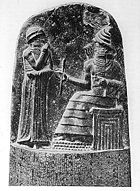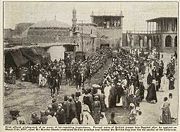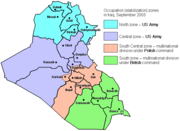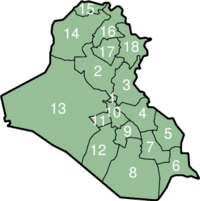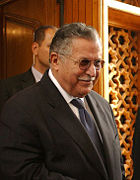Iraq
2008/9 Schools Wikipedia Selection. Related subjects: Middle Eastern Countries
| جمهورية العراق Jumhūriyyat ul-ʿIrāq (Arabic) كۆماری عێراق Komara Iraqê (Kurdish) Republic of Iraq
|
||||||
|---|---|---|---|---|---|---|
|
||||||
| Motto: الله أكبر (Arabic) " Allahu Akbar" ( transliteration) "God is the Greatest" |
||||||
| Anthem: Mawtini (new) Ardh Alforatain (previous)1 |
||||||
|
|
||||||
| Capital (and largest city) |
Baghdad2 |
|||||
| Official languages | Arabic, Kurdish | |||||
| Demonym | Iraqi | |||||
| Government | Developing parliamentary republic | |||||
| - | President | Jalal Talabani | ||||
| - | Prime Minister | Nouri al-Maliki | ||||
| Independence | ||||||
| - | from the Ottoman Empire |
October 1, 1919 |
||||
| - | from the United Kingdom |
October 3, 1932 |
||||
| Area | ||||||
| - | Total | 438,317 km² ( 58th) 169,234 sq mi |
||||
| - | Water (%) | 1.1 | ||||
| Population | ||||||
| - | 2006 estimate | 26,783,3834 ( 40th) | ||||
| - | Density | 66/km² ( 125th) 171/sq mi |
||||
| GDP ( PPP) | 2006 estimate | |||||
| - | Total | $89.8 billion ( 61st) | ||||
| - | Per capita | $2,900 ( 130th) | ||||
| Currency | Iraqi dinar ( IQD) |
|||||
| Time zone | AST ( UTC+3) | |||||
| - | Summer ( DST) | ADT ( UTC+4) | ||||
| Internet TLD | .iq | |||||
| Calling code | +964 | |||||
| 1 | The Kurds use Ey Reqîb. | |||||
| 2 | The capital of Iraqi Kurdistan is Arbil. | |||||
| 3 | Arabic and Kurdish are the official languages of the Iraqi government. According to Article 4, Section 4 of the Iraqi Constitution, Assyrian (Syriac) (a dialect of Aramaic) and Iraqi Turkmen (a dialect of Southern Azerbaijani) languages are official in areas where the respective populations they constitute density of population. | |||||
| 4 | [ CIA World Factbook] | |||||
The Federal Republic of Iraq, usually known as Iraq (Arabic: العراق , pronounced [ʕiˈrɑːq]), formerly known as Mesopotamia, is a country in the Middle East spanning most of the northwestern end of the Zagros mountain range, the eastern part of the Syrian Desert and the northern part of the Arabian Desert. It shares borders with Kuwait and Saudi Arabia to the south, Jordan to the west, Syria to the northwest, Turkey to the north, and Iran to the east. It has a very narrow section of coastline at Umm Qasr on the Persian Gulf. There are two major flowing rivers: the Tigris and the Euphrates. These provide Iraq with agriculturally capable land and contrast with the desert landscape that covers most of the Middle East.
The capital city, Baghdad, is in the centre-east. Iraq's rich history dates back to ancient Mesopotamia. The region between the Tigris and Euphrates rivers is identified as the Fertile Crescent—the cradle of civilization—and the birthplace of writing. During its long history, Iraq has been the centre of the Akkadian, Assyrian, Babylonian and Abbasid empires, and part of the Achaemenid, Macedonian, Parthian, Umayyad, Sassanid, Ottoman and British empires.
Since an invasion in 2003, a multinational coalition of forces, mainly American and British, has occupied Iraq. The invasion has had wide-reaching consequences: increased civil violence, political breakdown, the removal and execution of former authoritarian President Saddam Hussein, and national problems in the development of political balance, economy, infrastructure, and use of the country's huge reserves of oil. According to the 2007 Failed States Index, produced by the Carnegie Endowment for International Peace's Foreign Policy magazine and the Fund for Peace, Iraq has recently emerged as the world's second most unstable country, after Sudan. Under the control of the U.S. military, Iraq is developing a parliamentary democracy composed of 18 governorates (known as muhafadhat).
Etymology
The origin of the name "Iraq" (Arabic: العراق 'al-‘Irāq, Turkish: Irak, Assyrian: ܥܪܐܩ, Kurdish: عيَراق) is disputed. There are several suggested origins for the name. One dates to the Sumerian city of Uruk (or Erech); another maintains that Iraq comes from the Aramaic language, meaning "the land along the banks of the rivers"; another that Iraq refers to the root of a palm tree numerous in the country.
According to Professor Wilhelm Eilers, The name al-‘Irāq, for all its Arabic apperance, is derived from Middle Persian erāq "lowlands".
Under the Persian Sassanid dynasty, there was a region called "Erak Arabi," referring to the part of the south western region of the Persian Empire that is now part of southern Iraq. The name Al-Iraq was used by the Arabs themselves, from the 6th century, for the land Iraq covers.
In English, there are several ways of pronouncing Iraq.(1) [ɪ.ˈɹɑ(ː)k], (2) [ɪ.ˈɹæk]], (3) [aɪ.ˈɹæk]. (1) is the preferred pronunciation in most dictionaries, and the only pronunciation listed in the Oxford English Dictionary. MQD lists (2) first. (1) is closer to the Arabic than (2) is. The original Arabic pronunciation is [ʕiˈrɑːq].
Geography
Iraq is located at . Spanning 437,072 km² (168,743 sq mi), it is the 58th-largest country in the world. It is comparable in size to the US state of California, and somewhat larger than Paraguay.
Iraq mainly consists of desert, but between the two major rivers (Euphrates and Tigris) the area is fertile, the rivers carrying about 60 million cubic metres (78 million cu. yd) of silt annually to the delta. The north of the country is mostly composed of mountains; the highest point being at 3,611 metres (11,847 ft) point, unnamed on the map opposite, but known locally as Cheekah Dar (black tent). Iraq has a small coastline along the Persian Gulf. Close to the coast and along the Shatt al-Arab (known as arvandrūd: اروندرود among Iranians) there used to be marshlands, but many were drained in the 1990s.
The local climate is mostly desert, with mild to cool winters and dry, hot, cloudless summers. The northern mountainous regions have cold winters with occasional heavy snows, sometimes causing extensive flooding.
Comprising 112 billion barrels of proven oil, Iraq ranks second in the world behind Saudi Arabia in the amount of Oil reserves; the United States Department of Energy estimates that up to 90% of the country remains unexplored. These regions could yield an additional 100 billion barrels. Iraq's oil production costs are among the lowest in the world but only about 2,000 oil wells have been drilled in Iraq, compared with about 1 million wells in Texas alone.
History
Ancient Mesopotamia
The region of Iraq was historically known as Mesopotamia ( Greek: "between the rivers"). It was home to the world's first known civilization, the Sumerian culture, followed by the Akkadian, Babylonian, and Assyrian cultures, whose influence extended into neighboring regions as early as 5000 BC. These civilizations produced some of the earliest writing and some of the first sciences, mathematics, laws and philosophies of the world; hence its common epithet, the " Cradle of Civilization".
In the sixth century BC, Cyrus the Great conquered the Neo-Babylonian Empire, and Mesopotamia was subsumed in the Achaemenid Persian Empire for nearly four centuries. Alexander the Great conquered the region again, putting it under Macedonian rule for nearly two centuries. A Central Asian tribe of ancient Iranian peoples known as the Parthians later annexed the region, followed by the Sassanid Persians. The region remained a province of the Persian Empire for nine centuries, until the 7th century.
Islamic Caliphate
Beginning in the seventh century AD, Islam spread to what is now Iraq during the Islamic conquest of Persia, led by the Muslim Arab commander Khalid ibn al-Walid. Under the Rashidun Caliphate, the prophet Mohammed's cousin and son-in-law Ali moved his capital to Kufa "fi al-Iraq" when he became the fourth caliph. The Umayyad Caliphate ruled the province of Iraq from Damascus in the 7th century. (However, eventually there was a separate, independent Caliphate of Cordoba.)
The Abbasid Caliphate built the city of Baghdad in the 8th century as their capital, and it became the leading metropolis of the Arab and Muslim world for five centuries. Baghdad was the largest multicultural city of the Middle Ages, peaking at a population of more than a million, and was the centre of learning during the Islamic Golden Age. The Mongols destroyed the city during the sack of Baghdad in the 13th century.
Mongol Conquest
In 1257, Hulagu Khan amassed an unusually large army, a significant portion of the Mongol Empire's forces, for the purpose of conquering Baghdad. When they arrived at the Islamic capital, Hulagu demanded surrender but the caliph refused. This angered Hulagu, and, consistent with Mongol strategy of discouraging resistance, Baghdad was decimated. Estimates of the number of dead range from 200,000 to a million.
The Mongols destroyed the Abbasid Caliphate and The Grand Library of Baghdad (Arabic بيت الحكمة Bayt al-Hikma, lit., House of Wisdom), which contained countless, precious, historical documents. The city would never regain its status as major centre of culture and influence.
In 1401, warlord of Turco-Mongol descent Tamerlane (Timur Lenk) invaded Iraq. After the capture of Bagdad, 20,000 of its citizens were massacred. Timur ordered that every soldier should return with at least two severed human heads to show him (many warriors were so scared they killed prisoners captured earlier in the campaign just to ensure they had heads to present to Timur).
Ottoman Empire
Later, the Ottoman Turks took Baghdad from the Persians in 1535. The Ottomans lost Baghdad to the Iranian Safavids in 1609, and took it back in 1632. From 1747 to 1831, Iraq was ruled, with short intermissions, by the Mamluk officers of Georgian origin who enjoyed local autonomy from the Sublime Porte. In 1831, the direct Ottoman rule was imposed and lasted until World War I, during which the Ottomans sided with Germany and the Central Powers.
During World War I the Ottomans were driven from much of the area by the United Kingdom during the dissolution of the Ottoman Empire. The British lost 92,000 soldiers in the Mesopotamian campaign. Ottoman losses are unknown but the British captured a total of 45,000 prisoners of war. By the end of 1918 the British had deployed 410,000 men in the area, though only 112,000 were combat troops.
During World War I the British and French divided the Middle East in the Sykes-Picot Agreement. The Treaty of Sèvres, which was ratified in the Treaty of Lausanne, led to the advent of the modern Middle East and Republic of Turkey. The League of Nations granted France mandates over Syria and Lebanon and granted the United Kingdom mandates over Iraq and Palestine (which then consisted of two autonomous regions: Palestine and Transjordan). Parts of the Ottoman Empire on the Arabian Peninsula became parts of what are today Saudi Arabia and Yemen.
British Mandate of Mesopotamia
At the end of World War I, the League of Nations granted the area to the United Kingdom as a mandate. It initially formed two former Ottoman vilayets (regions): Baghdad, and Basra into a single country in August 1921. Five years later, in 1926, the northern vilayet of Mosul was added, forming the territorial boundaries of the modern Iraqi state.
For three out of four centuries of Ottoman rule, Baghdad was the seat of administration for the vilayets of Baghdad, Mosul, and Basra. During the mandate, British colonial administrators ruled the country, and through the use of British armed forces, suppressed Arab and Kurdish rebellions against the occupation. They established the Hashemite king, Faisal, who had been forced out of Syria by the French, as their client ruler. Likewise, British authorities selected Sunni Arab elites from the region for appointments to government and ministry offices.
Hashemite monarchy
Britain granted independence to Iraq in 1932, on the urging of King Faisal, though the British retained military bases and transit rights for their forces. King Ghazi of Iraq ruled as a figurehead after King Faisal's death in 1933, while undermined by attempted military coups, until his death in 1939. The United Kingdom invaded Iraq in 1941, for fear that the government of Rashid Ali al-Gaylani might cut oil supplies to Western nations, and because of his strong ideological leanings to Nazi Germany. A military occupation followed the restoration of the Hashemite monarchy, and the occupation ended on October 26, 1947. The rulers during the occupation and the remainder of the Hashemite monarchy were Nuri al-Said, the autocratic prime minister, who also ruled from 1930–1932, and 'Abd al-Ilah, an advisor to the king Faisal II.
Republic of Iraq
The reinstated Hashemite monarchy lasted until 1958, when it was overthrown by a coup d'etat of the Iraqi Army, known as the 14 July Revolution. The coup brought Brigadier General Abdul Karim Qassim to power. He withdrew from the Baghdad Pact and established friendly relations with the Soviet Union, but his government lasted only until 1963, when it was overthrown by Colonel Abdul Salam Arif. Salam Arif died in 1966 and his brother, Abdul Rahman Arif, assumed the presidency. In 1968, Rahman Arif was overthrown by the Arab Socialist Baath Party. This movement gradually came under the control of Saddam Hussein al-Majid al Tikriti, who acceded to the presidency and control of the Revolutionary Command Council (RCC), then Iraq's supreme executive body, in July 1979, while killing many of his opponents.
Saddam Hussein
Saddam's regime lasted throughout the Iran-Iraq War (1980–1988), during which Iraqi forces attacked Iranian soldiers and civilians with chemical weapons. This period is notorious for the Saddam regime's human rights abuses, for instance, during the Al-Anfal campaign. The war ended in stalemate, largely due to American and Western support for Iraq. This was part of the US policy of "dual containment" of Iraq and Iran.
In 1977, the Iraqi government ordered the construction of Osirak (also spelled Osiraq) at the Al Tuwaitha Nuclear Research Centre, 18 km (11 miles) south-east of Baghdad. It was a 40 MW light-water nuclear materials testing reactor (MTR). In 1981, Israeli aircraft bombed the facility, in order to prevent the country from using the reactor for creation of nuclear weapons.
In 1990, Iraq invaded Kuwait, resulting in the Gulf War and economic sanctions imposed by the United Nations at the behest of the U.S. The economic sanctions were intended to compel Saddam to dispose of weapons of mass destruction. Critics estimate that more than 500,000 Iraqi children died as a result of the sanctions. The U.S. and the UK declared no-fly zones over Kurdish northern and Shiite southern Iraq to oversee the Kurds and southern Shiites.
Invasion by American-led Coalition forces

In March 2003, a United States-organized coalition invaded Iraq, with the stated reason that Iraq had failed to abandon its nuclear and chemical weapons development program in violation of United Nations resolution 687. When Iraq invaded Kuwait during the first Gulf War, the United Nations Security Council, under Chapter VII of the United Nations Charter, adopted resolution 678, authorizing U.N. member states to use "all necessary means" to "restore international peace and security in the area." After Iraq was expelled from Kuwait the United Nations passed a cease-fire resolution 687. The agreement included provisions obligating Iraq to discontinue its nuclear weapons program. The United States asserted that because Iraq was in "material breach" of resolution 687, the armed forces authorization of resolution 678 was revived.
The United States gave further justification for the invasion of Iraq in claims that Iraq had or was developing weapons of mass destruction and the opportunity to remove an oppressive dictator from power and bring democracy to Iraq. In his State of Union Address on 29 January, 2002, the American President George W. Bush declared that Iraq was a member of the "axis of evil", and that, like North Korea and Iran, Iraq's attempt to acquire weapons of mass destruction gave credence to the claim that the Iraqi government posed a serious threat to America's national security. He added, "Iraq continues to flaunt its hostilities toward America and to support terror. The Iraqi regime has plotted to develop anthrax, and nerve gas, and nuclear weapons for over a decade... This is a regime that agreed to international inspections—then kicked out inspectors. This is a regime that has something to hide from the civilized world... By seeking weapons of mass destruction, these regimes [Iran, Iraq and North Korea] pose a grave and growing danger. They could provide these arms to terrorists, giving them the means to match their hatred." However, no Iraqi weapons of mass destruction have been found since the invasion.
Post-invasion
Following the invasion, the United States established the Coalition Provisional Authority to govern Iraq. Government authority was transferred to an Iraqi Interim Government in June 2004 and a permanent government was elected in October 2005. More than 140,000 Coalition troops remain in Iraq.
Studies have placed the number of civilians deaths as high as 655,000 (see The Lancet study), although most studies have put the number much lower: the Iraq Body Count project has a figure of less than 10% of The Lancet Study. The website of the Iraq body count however states, "Our maximum therefore refers to reported deaths - which can only be a sample of true deaths unless one assumes that every civilian death has been reported. It is likely that many if not most civilian casualties will go unreported by the media." .
After the invasion, al-Qaeda took advantage of the insurgency to entrench itself in the country concurrently with an Arab-Sunni led insurgency and sectarian violence.
On December 30, 2006, Saddam Hussein was hanged . Hussein's half-brother and former intelligence chief Barzan Hassan and former chief judge of the Revolutionary Court Awad Hamed al-Bandar were likewise executed on January 15, 2007; as was Taha Yassin Ramadan, Saddam's former deputy and former vice-president (originally sentenced to life in prison but later to death by hanging), on March 20, 2007. Ramadan was the fourth and last man in the al-Dujail trial to die by hanging for crimes against humanity.
At the Anfal genocide trial, Saddam's cousin Ali Hassan al-Majid (aka Chemical Ali), former defense minister Sultan Hashim Ahmed al-Tay, and former deputy Hussein Rashid Mohammed were sentenced to hang for their role in the Al-Anfal Campaign against the Kurds on June 24, 2007.
Acts of sectarian violence have led to claims of ethnic cleansing in Iraq, and there have been many attacks on Iraqi minorities such as the Yezidis, Mandeans, Assyrians and others.
In 2007 Foreign Policy Magazine named Iraq as the second most unstable nation in the world after Sudan.
Although violence has declined from the summer of 2007, the U.N. reported of a cholera outbreak in Iraq.
Iraqi diaspora
The dispersion of native Iraqis to other countries is known as the Iraqi diaspora. There have been many large-scale waves of emigration from Iraq, beginning early in the regime of Saddam Hussein and continuing through to 2007. The UN High Commission for Refugees has estimated that nearly two million Iraqis have fled the country in recent years, mostly to Jordan and Syria. Although some expatriates returned to Iraq after the 2003 invasion, the flow had virtually stopped by 2006.
In addition to the 2 million Iraqis who fled to neighbouring countries, the Internal Displacement Monitoring Centre estimates the number of people currently displaced within the country at 1.9 million.
Roughly 40% of Iraq's middle class is believed to have fled, the U.N. said. Most are fleeing systematic persecution and have no desire to return. Refugees are mired in poverty as they are generally barred from working in their host countries.
In recent times the Diaspora seems to be reversing with the increased security of the last few months, and the Iraqi government claims that so far 46,000 refugees have returned to their homes in October of 2007 alone ..
Government and politics
Government
The federal government of Iraq is defined under the current Constitution as an Islamic, democratic, federal parliamentary republic. The federal government is composed of the executive, legislative, and judicial branches, as well as numerous independent commissions. Aside from the federal government, there are regions (made of one or more governorates), governorates, and districts within Iraq with jurisdiction over various matters as defined by law.
Regions, governorates and districts
Currently, Kurdistan is the only legally defined region within Iraq, with its own government and quasi-official militia, the Peshmerga. Iraq itself is divided into eighteen governorates (or provinces) (Arabic: muhafadhat, singular - muhafadhah, Kurdish: پاریزگه Pârizgah). The governorates are subdivided into districts (or qadhas).
|
|
Politics
Iraq was under Baath Party rule from 1968 to 2003; in 1979 Saddam Hussein took control and remained president until 2003 after which he was unseated by a US-led invasion.
On October 15, 2005, more than 63% of eligible Iraqis came out across the country to vote on whether to accept or reject the new constitution. On October 25, the vote was certified and the constitution passed with a 78% overall majority, with the percentage of support varying widely between the country's territories. The new constitution had overwhelming backing among the Shia and Ķurdish communities, but was overwhelmingly rejected by Arab Sunnis. Three majority Arab Sunni provinces rejected it ( Salah ad Din with 82% against, Ninawa with 55% against, and Al Anbar with 97% against).
Under the terms of the constitution, the country conducted fresh nationwide parliamentary elections on December 15 to elect a new government. The overwhelming majority of all three major ethnic groups in Iraq voted along ethnic lines, turning this vote into more of an ethnic census than a competitive election, and setting the stage for the division of the country along ethnic lines.
Iraqi politicians have been under significant threat by the various factions that have promoted violence as a political weapon. The ongoing violence in Iraq has been incited by an amalgam of religious extremists that believe an Islamic Caliphate should rule, old sectarian regime members that had ruled under Saddam that want back the power they had, and Iraqi nationalists that are fighting the U.S. military presence.
Iraq has number of ethnic minority groups in Iraq: Kurds, Assyrians, Mandeans, Iraqi Turkmen, Shabaks and Roma. These groups have not enjoyed equal status with the majority Arab populations throughout Iraq's eighty-five year history. Since the establishment of the "no-fly zones" following the Gulf War of 1990–1991, the situation of the Kurds has changed as they have established their own autonomous region. The remainder of these ethnic groups continue to suffer discrimination on religious or ethnic grounds.
Economy
Iraq's economy is dominated by the oil sector, which has traditionally provided about 95% of foreign exchange earnings. In the 1980s financial problems caused by massive expenditures in the eight-year war with Iran and damage to oil export facilities by Iran led the government to implement austerity measures, borrow heavily, and later reschedule foreign debt payments. Iraq suffered economic losses from the war of at least US$100 billion. After hostilities ended in 1988, oil exports gradually increased with the construction of new pipelines and restoration of damaged facilities. A combination of low oil prices, repayment of war debts (estimated at around US$3 billion a year) and the costs of reconstruction resulted in a serious financial crisis which was the main short term motivation for the invasion of Kuwait.
On November 20, 2004, the Paris Club of creditor nations agreed to write off 80% ($33 billion) of Iraq's $42 billion debt to Club members. Iraq's total external debt was around $120 billion at the time of the 2003 invasion, and had grown by $5 billion by 2004. The debt relief will be implemented in three stages: two of 30% each and one of 20%.
At the end of 2005, and in the first half of 2006, Iraq implemented a restructuring of about $20 billion of commercial debt claims on terms comparable to that of its November 2004 Paris Club agreement (i.e. with an 80% writeoff). Iraq offered to its larger claimants a U.S. dollar denominated bond maturing in 2028. Smaller commercial claimants received a cash settlement of comparable value.
Reconstruction
Demographics
A July 2006 estimate of the total Iraqi population is 26,783,383.
Seventy-four percent of Iraq's population are Arabs; the other major ethnic groups are the Kurds at 20.54%, Assyrians, Iraqi Turkmen and others (5%), who mostly live in the north and northeast of the country. Other distinct groups are Persians and Armenians. About 25,000–60,000 Marsh Arabs live in southern Iraq.
Arabic and Kurdish are official languages. Assyrian and Turkmen are official languages in areas where the Assyrians and Iraqi Turkmen are located respectively. Armenian and Persian are also spoken but to a lesser extent. English is the most commonly spoken Western language.
Ethnic composition includes:
Religious composition includes:
- Muslim, 97%; Christian or other, 3%.
There are no official figures available, mainly due to the highly politically charged nature of the subject. Two estimates of the Muslim proportions of the population are:
- Shi'a as much as 60%, Sunni about 40% (source: Britannica, Religion section of Iraq article).
Shi'a 60%-65%, Sunni 32%-37% (source: CIA World Fact Book).
The Shi'a are mostly Arabs, some are Turkmen and Faili Kurds, and almost all are Twelver school. Sunnis are composed of Arabs, Turkmen who are Hanafi school and Kurds who are Shafi school.
According to most western sources the majority of Iraqis are Shi'ite Arab Muslims (around 60%), and Sunnis represent about 40% of the population made up of Arabs, Kurds and Turkmen. Sunnis hotly dispute these figures, including an ex-Iraqi Ambassador, referring to American sources. They claim that many reports or sources only include Arab Sunnis as 'Sunni', missing out the Kurdish and Turkmen Sunnis.
Ethnic Assyrians (most of whom are adherents of the Chaldean Catholic Church, Syriac Orthodox Church and the Assyrian Church of the East) account for most of Iraq's Christian population, along with Armenians. Bahá'ís, Mandaeans, Shabaks, and Yezidis also exist. Most Kurds are Sunni Muslims, although the Faili (Feyli) Kurds are largely Shi'a.
As of November 4, 2006, the UNHCR estimated that 1.8 million Iraqis had been displaced to neighboring countries, and 1.6 million were displaced internally, with nearly 100,000 Iraqis fleeing to Syria and Jordan each month. A May 25, 2007 article notes that in the past seven months only 69 people from Iraq have been granted refugee status in the United States.
Culture
In the most recent millennium, what is now Iraq has been made up of five cultural areas: Kurdish in the north centered on Arbil, Sunni Islamic Arabs in the centre around Baghdad, Shi'a Islamic Arabs in the south centered on Basra, the Assyrians, a Christian people, living in various cities in the north, and the Marsh Arabs, a nomadic people, who live on the marshlands of the central river. There are also the Bedouin tribes primarily in southern and western Iraq, with smaller groups scattered throughout the country. Markets and bartering are the common form of trade.
Music
Iraq is known primarily for an instrument called the oud (similar to a lute) and a rebab (similar to a fiddle); its stars include Ahmed Mukhtar and the Assyrian Munir Bashir. Until the fall of Saddam Hussein, the most popular radio station was the Voice of Youth. It played a mix of western rock, hip hop and pop music, all of which had to be imported via Jordan due to international economic sanctions. Iraq has also produced a major pan-Arab pop star-in-exile in Kathem Al Saher, whose songs include Ladghat E-Hayya, which was banned for its racy lyrics.


